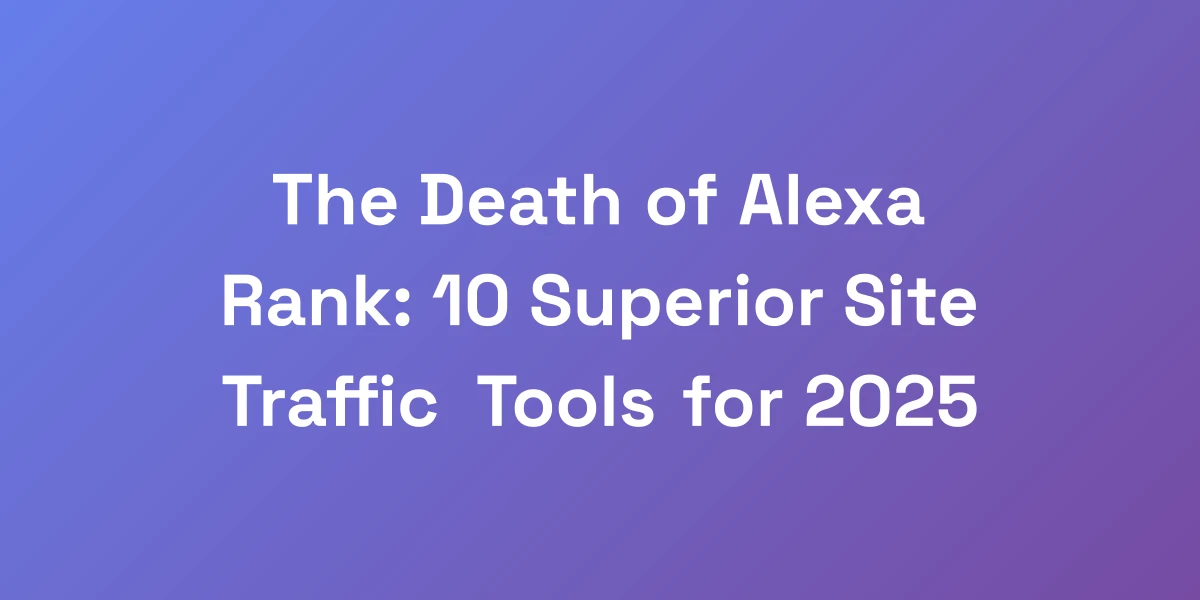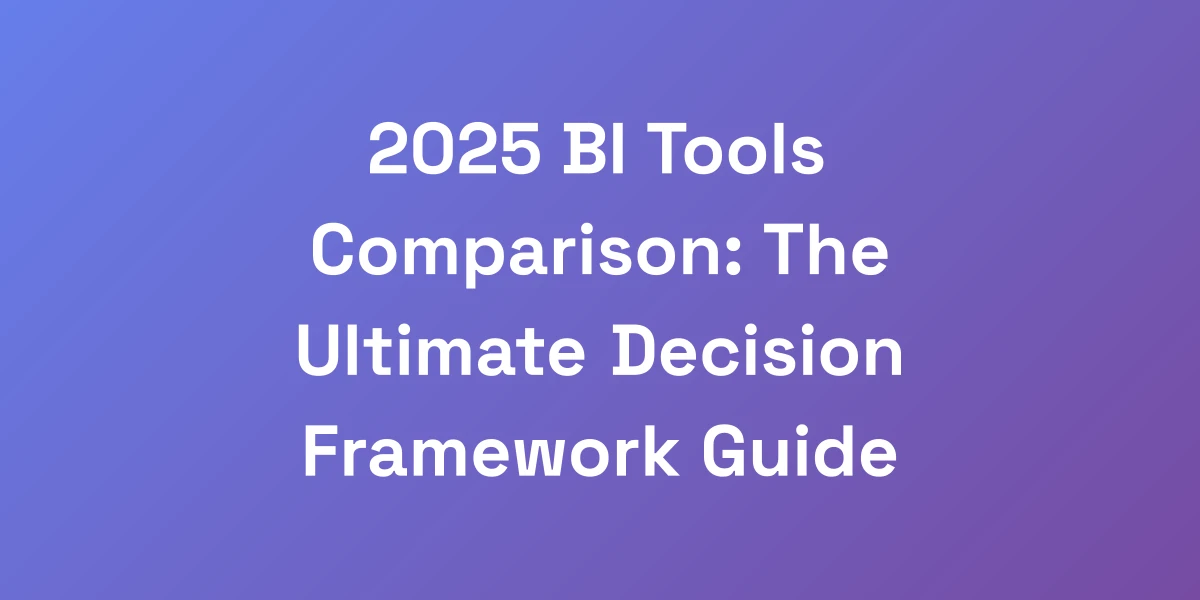
The Death of Alexa Rank: 10 Superior Site Traffic Tools for 2025
Mar 22, 2025 | By [email protected]
Introduction
When Alexa Rank fell silent, the digital marketing world felt a seismic shift. We’ve been relying on it for over two decades, trusting it to gauge our online presence. But here’s the kicker: Alexa’s demise wasn’t the end of the road for website traffic analysis—it was a signal for a new era.
Marketers scrambled, unsure of where to turn. The old guard was gone, leaving a void filled with uncertainty and opportunity. But while many panicked, the savvy entrepreneurs among us saw a chance to revolutionize our strategies with superior tools. Gone are the days when a single rank could define your site’s success. Today, we have a arsenal of advanced analytics platforms that offer deeper, more actionable insights. Ready to ditch the outdated Alexa Rank and embrace the future? Let’s dive in.
The Rise and Fall of Alexa’s Website Traffic Analytics
Let me hit you with some truth: Alexa’s death shocked the digital marketing world, but it opened doors to better, more accurate traffic analysis tools. After serving the internet for 25 years and being acquired by Amazon for $250M, Alexa’s retirement left a gap. But here’s the thing – while everyone’s panicking about losing their precious Alexa rank, smart marketers are already leveraging superior alternatives that provide more detailed, accurate, and actionable data.
Alexa’s Journey: From Internet Pioneer to Retirement
Alexa.com started as a simple website ranking tool, helping businesses understand their online standing. Acquired by Amazon, it garnered widespread use, becoming a staple in digital marketing.
For years, Alexa provided valuable insights into site traffic, user demographics, and engagement metrics. It became synonymous with website credibility—higher Alexa ranks were often equated with greater trust and authority.
However, as the internet evolved, so did the demands for more sophisticated analytics. Alexa struggled to keep up with the rapid advancements in web technologies and data analysis techniques, ultimately leading to its downfall.
Why Alexa’s Traffic Metrics Became Unreliable
So, why did Alexa’s metrics become unreliable? The primary issue was data accuracy. Alexa relied heavily on browser extensions and partnerships to gather data, which meant its metrics were often skewed and not representative of the broader internet traffic.
As privacy concerns grew and users became more aware of data collection practices, Alexa’s data sources dwindled. The platform couldn’t adapt quickly enough to these changes, resulting in less accurate traffic estimates that no longer reflected real user behavior.
Moreover, Alexa’s ranking system was overly simplistic. It provided a single metric that many interpreted as the definitive measure of site popularity, ignoring the multifaceted nature of modern web traffic and user engagement.
The Impact on Digital Marketing and SEO
Alexa’s decline has significant implications for digital marketing and SEO. Marketers relied on Alexa Rank to benchmark their performance and strategize accordingly. With its unreliability, businesses struggled to gauge their true online presence.
This gap forced marketers to seek out alternative tools that offered more comprehensive and precise data. The shift away from Alexa Rank has led to a more data-driven approach, where decisions are based on detailed analytics rather than a single ranking metric.
In essence, the fall of Alexa pushed the industry toward more robust and nuanced traffic analysis tools, ultimately benefiting businesses by providing them with better insights to drive growth.
Understanding the Limitations of Alexa’s Ranking System
Alexa’s ranking system was built on a combination of traffic data and page views. However, it had several limitations:
- Data Collection Methods: Relying on browser extensions and partnerships limited the scope and accuracy of data collection.
- Single Metric Focus: The Alexa Rank was a one-dimensional metric that didn’t account for user behavior, conversion rates, or engagement levels.
- Global vs. Local Data: Alexa’s global ranking often missed regional nuances, making it less useful for localized SEO strategies.
- Lag in Data Updates: The frequency of data updates wasn’t sufficient to keep up with the dynamic nature of web traffic.
These limitations made Alexa less effective as a reliable tool for modern digital marketing needs, highlighting the necessity for more advanced analytics solutions.
Modern Alternatives That Crush Alexa’s Capabilities
Listen, I’m going to share something that most “gurus” won’t tell you: website traffic analysis has evolved beyond simple rankings. The new generation of analytics tools doesn’t just tell you where you stand—they show you exactly how to climb higher. We’re talking about platforms that combine AI-driven insights, real-time data, and predictive analytics. These tools don’t just measure your traffic; they help you multiply it exponentially.
Semrush: The All-in-One Traffic Analytics Powerhouse
Semrush stands as a titan in the traffic analytics space. It’s not just a tool; it’s your complete digital marketing arsenal.
With comprehensive features like keyword research, competitor analysis, and site audits, Semrush provides deep insights into your traffic sources and SEO performance.
- Competitive Intelligence: Understand what your competitors are doing and find opportunities to outperform them.
- Keyword Research: Discover high-performing keywords to drive more targeted traffic.
- Site Audit: Identify and fix SEO issues that could be hindering your traffic growth.
In real-world applications, businesses using Semrush have seen significant improvements in their traffic and overall online performance by leveraging its robust analytics and actionable insights.
Actionable Tip: Use Semrush’s Traffic Analytics to identify your top-performing pages and replicate their success across your site.
Similarweb: Advanced Market Intelligence Platform
Similarweb offers advanced market intelligence, providing a holistic view of your website’s performance within your industry.
Its strength lies in its ability to deliver comprehensive data on traffic sources, audience behavior, and market trends.
- Market Overview: Gain insights into market dynamics and identify emerging trends.
- Audience Insights: Understand your audience’s behavior, preferences, and demographics.
- Competitor Analysis: Benchmark your performance against industry leaders and uncover growth opportunities.
Companies leveraging Similarweb can make informed decisions based on a wide range of data points, enhancing their strategic planning and execution.
Actionable Tip: Utilize Similarweb to track competitor traffic sources and adapt your strategies to capture similar traffic segments.
Ahrefs: Deep Traffic and SEO Analysis
Ahrefs is renowned for its exceptional backlink analysis and SEO tools, making it a favorite among SEO professionals.
Its robust features provide in-depth insights into your website’s SEO performance and traffic dynamics.
- Backlink Analysis: Discover high-quality backlinks and understand their impact on your SEO.
- Keyword Explorer: Find and analyze keywords that can drive more traffic to your site.
- Content Explorer: Identify top-performing content in your niche and develop your content strategy.
Businesses using Ahrefs have successfully enhanced their search engine rankings and increased organic traffic by leveraging its detailed SEO insights.
Actionable Tip: Use Ahrefs to identify and acquire backlinks from high-authority sites to boost your SEO performance.
Google Search Console: The Free but Powerful Alternative
Google Search Console is a free tool that offers powerful insights into your website’s search performance.
Despite being free, it provides invaluable data that can help you optimize your site effectively.
- Performance Reports: Track your site’s search performance, including clicks, impressions, and average position.
- Index Coverage: Ensure your pages are properly indexed and free from errors.
- Enhancements: Utilize data on mobile usability, structured data, and more to improve your site’s performance.
Even without a hefty price tag, Google Search Console equips businesses with the necessary tools to monitor and enhance their search presence.
Actionable Tip: Regularly review your Performance Reports to identify high-performing queries and optimize your content accordingly.
Cloudflare Analytics: Real-Time Traffic Insights
Cloudflare Analytics offers real-time traffic insights, providing a clear picture of your website’s performance and security.
Its unique blend of performance metrics and security data makes it a versatile tool for comprehensive site analysis.
- Real-Time Monitoring: Get instant insights into your site’s traffic and performance metrics.
- Security Insights: Monitor potential security threats and understand their impact on your traffic.
- Performance Optimization: Use data-driven insights to enhance your site’s speed and user experience.
Businesses utilizing Cloudflare Analytics benefit from its real-time data, which allows for immediate adjustments and improvements to their online strategies.
Actionable Tip: Leverage Cloudflare’s real-time insights to quickly identify and address performance bottlenecks.
Choosing the Right Traffic Analysis Tool for Your Business
Here’s the brutal reality: most businesses waste thousands on analytics tools they don’t need. Your choice of traffic analysis tool should align with your specific goals and scale. We’ve personally tested dozens of platforms, spending over $100,000 on various solutions. What we’ve learned is that the best tool isn’t always the most expensive – it’s the one that gives you actionable insights that drive revenue growth.
Defining Your Traffic Analysis Goals
Before investing in any tool, clearly define what you aim to achieve with your traffic analysis.
- Increase Organic Traffic: Focus on tools that offer robust SEO and keyword analysis features.
- Understand User Behavior: Choose platforms that provide detailed audience insights and behavior tracking.
- Improve Conversion Rates: Select tools that integrate with your marketing and sales platforms to track conversions.
By pinpointing your primary objectives, you can choose a tool that directly addresses your needs, ensuring a better return on investment.
Actionable Tip: List your top three traffic analysis goals and match them with the features offered by potential tools.
Budget Considerations vs. ROI
It’s easy to get dazzled by expensive tools promising the moon, but consider the return on investment instead.
- Cost vs. Features: Evaluate whether the features offered justify the cost. A cheaper tool with all the necessary features can outperform an expensive one with redundant capabilities.
- Scalability: Choose a tool that grows with your business, avoiding the need for frequent upgrades or replacements.
- Hidden Costs: Be aware of any additional costs, such as premium support or data exports.
Balancing your budget with the potential ROI ensures that you’re not overspending on tools that don’t contribute to your growth.
Actionable Tip: Calculate the expected ROI from each tool based on your traffic goals and choose the one that offers the best value for your investment.
Essential Features for Different Business Types
Different businesses have different needs. Here’s a quick breakdown:
- E-commerce: Focus on tools that offer detailed sales funnel analysis and conversion tracking.
- Content Publishers: Opt for platforms that provide in-depth content performance metrics and SEO insights.
- B2B Services: Choose tools with robust lead tracking and integration with CRM systems.
By matching the tool’s features with your business type, you ensure that you’re getting the most relevant and useful data to drive your strategies.
Actionable Tip: Identify the top three features that are critical for your business type and prioritize tools that excel in those areas.
Data Accuracy and Reliability Factors
Data is only as good as its accuracy and reliability. Here’s what to look for:
- Real-Time Data: Ensure the tool provides up-to-date information to make timely decisions.
- Comprehensive Data Sources: Choose platforms that aggregate data from multiple sources for a more complete picture.
- Consistency: Reliable tools offer consistent data tracking and reporting, avoiding fluctuations that can mislead your analysis.
Accurate data leads to better insights and more effective strategies, making it a critical factor in choosing the right tool.
Actionable Tip: Test the data accuracy by comparing small samples of data from multiple tools to see which one aligns best with your expectations.
Integration Capabilities with Existing Tools
Your traffic analysis tool should seamlessly integrate with your existing tech stack to maximize its utility.
- CRM Integration: Ensure the tool can connect with your CRM for comprehensive lead tracking and customer insights.
- Marketing Platforms: Integration with email marketing, social media, and advertising platforms can streamline your workflows.
- Data Export Options: Being able to export data easily for use in other applications or reports is crucial.
Effective integration saves time and ensures that your data flows smoothly across different systems, enhancing overall efficiency.
Actionable Tip: Create a list of your current tools and verify that your chosen traffic analysis platform offers seamless integration with each one.
Maximizing Your Traffic Analytics Investment
Stop thinking about traffic analysis as just numbers on a screen. Every data point is a potential dollar in your pocket if you know how to leverage it. We’ve helped businesses turn basic traffic insights into million-dollar opportunities. The secret isn’t in the tools themselves—it’s in how you interpret and act on the data. Let us show you how to turn these metrics into money-making decisions.
Creating an Effective Analytics Dashboard
An effective analytics dashboard is your command center. It should display the most critical metrics at a glance and allow you to drill down for more detailed insights.
- Key Metrics: Display metrics that align with your business goals, such as traffic sources, conversion rates, and bounce rates.
- Customization: Customize your dashboard to focus on the data that matters most to you, avoiding information overload.
- Visualization: Use charts and graphs to make data easily understandable and actionable.
A well-crafted dashboard makes it easier to monitor performance and quickly identify areas that need attention.
Actionable Tip: Regularly update and refine your dashboard to ensure it continues to meet your evolving business needs.
Key Metrics That Actually Matter for Growth
Focusing on the right metrics is crucial for driving growth. Here are the ones that matter:
- Traffic Sources: Know where your visitors are coming from to optimize your marketing efforts.
- Conversion Rate: Track how many visitors are taking desired actions, such as making a purchase or signing up for a newsletter.
- Bounce Rate: Understand how many visitors leave your site after viewing only one page to improve engagement.
- Average Session Duration: Measure how long users stay on your site to gauge content effectiveness.
- Pages Per Session: Assess how many pages a user visits in a single session to understand site navigation and content appeal.
These metrics provide a comprehensive view of your site’s performance and highlight areas for improvement.
Actionable Tip: Set up goal tracking for each key metric and monitor them regularly to identify trends and adjust your strategies accordingly.
Turning Data into Action Steps
Data alone isn’t enough—you need to translate it into actionable steps that drive results.
- Identify Patterns: Look for trends in your data that indicate what’s working and what isn’t.
- Set SMART Goals: Based on your data insights, set Specific, Measurable, Achievable, Relevant, and Time-bound goals.
- Implement Changes: Use your insights to make informed changes to your website, content, and marketing strategies.
By systematically analyzing your data and taking targeted actions, you can continuously improve your site’s performance.
Actionable Tip: After reviewing your analytics, choose one area to improve each month and implement a strategy to address it.
Tracking and Improving ROI
Understanding your return on investment (ROI) ensures that your traffic analytics efforts are paying off.
- Calculate ROI: Compare the costs of your analytics tools against the revenue generated from data-driven decisions.
- Optimize Spending: Allocate more resources to the channels and strategies that deliver the highest ROI.
- Continuous Improvement: Regularly assess your ROI and adjust your strategies to maximize returns.
Tracking ROI helps you make financially sound decisions and ensures that your analytics investments contribute to your bottom line.
Actionable Tip: Use your analytics tool’s ROI tracking features to monitor the financial impact of your marketing campaigns and strategies.
Common Analytics Mistakes to Avoid
Even the best tools can lead you astray if you fall into common analytics pitfalls. Here’s what to avoid:
- Ignoring Data Quality: Poor data quality can lead to inaccurate insights. Ensure your data sources are reliable and your tracking is set up correctly.
- Focusing on Vanity Metrics: Metrics like page views and visits are important, but they don’t necessarily translate to business growth. Focus on actionable metrics that align with your goals.
- Lack of Regular Analysis: Analytics is most effective when reviewed regularly. Set aside dedicated time to analyze your data and make informed decisions.
By steering clear of these mistakes, you ensure that your analytics efforts are both accurate and effective.
Actionable Tip: Schedule regular analytics reviews as part of your monthly routine to stay on top of your data and make timely adjustments to your strategies.
Conclusion
The death of Alexa Rank was more than just the end of a tool—it was the beginning of a new chapter in website traffic analysis. As we leave behind the outdated metrics, we embrace a future filled with advanced, actionable insights that drive real growth.
We’ve explored ten superior traffic analysis tools that not only replace Alexa but exceed its capabilities, offering deeper, more precise data to guide your strategies. From Semrush’s all-in-one powerhouse to Google Search Console’s free yet powerful features, these tools provide the insights you need to thrive in 2025 and beyond.
Ready to take your traffic analysis to the next level? Choose the right tool, align it with your goals, and turn those data points into actionable strategies that drive revenue. Don’t just track your traffic—transform it into a powerful growth engine for your business.
What’s your go-to traffic analysis tool now that Alexa Rank is history? Share your experiences and let’s continue the conversation on how to maximize our online presence in this new era.








